Today is International Holocaust Remembrance Day, aka “Auschwitz Day”, as it was on this date, 27 January, that in 1945 the Soviet Red Army arrived at Auschwitz and liberated the camp, after the SS had largely “evacuated” it already and sent most of its inmates on death marches, to camps further away from the westward-moving front line in a WWII that was already de facto lost for Germany.
It also so happened that a little earlier this month I revisited the memorial sites at Auschwitz as part of a six-day trip to Kraków and Oświęcim, planned at short notice. So I decided to do another Auschwitz Day post (see also this older one from 2022 and also the one from the year before that). I had first been to Auschwitz in March 2008, so almost 16 years ago. And indeed lots of changes since then have to be reported.
I assume that most readers of this Blog will be more or less familiar with the history of Auschwitz (if you’re not, then there are countless sources out there that can fill you in, from short synopsis texts to multi-volume book releases, indeed whole libraries). So I won’t dwell so much on the historical background but rather concentrate on what has changed at the sites for visitors today.
To begin with, the main entrance at Auschwitz 1 was moved to a new location last summer – as my wife and I found out the hard way, because I followed Google Maps, and that hadn’t yet been updated to cover this change. So we were dropped off by the minibus we had taken from Kraków right at the new entrance … but then couldn’t locate the hotel I had booked, which was supposed to be almost right opposite the entrance. It indeed used to be so close to the old entrance, but now it’s quite a walk away, all around the memorial site’s walls. As it was winter and really snowy we grabbed a taxi instead. And after check-in called another taxi to take us to Auschwitz-Birkenau, which on this occasion we intended to visit first.
On arrival at the infamous gatehouse and entrance to that part of the memorial we found a new security gate staffed by grim guards who informed us that visits for individuals, i.e. those not on a guided tour, would only be possible after 1 p.m. and that entry passes, although free of charge for individuals, had to be obtained in advance from the main entrance to Auschwitz 1.
But I also found that the free shuttle buses that run between Auschwitz 1 and Birkenau now apparently operate year round and are fairly frequent (between every ten and twenty minutes). So we hopped on the next one coming along and made our way back to Auschwitz 1. There we got the entry passes, for which you have to provide your names for the ID checks later when entering the memorial site. It was not possible to obtain passes for the next day, when we wanted to visit the museum site at Auschwitz 1. And again, entry for individuals would also be allowed only after 1 p.m. there, so for a morning visit we would have to join a guided tour. We noted the start times of these and then hopped back on the shuttle to Birkenau.
The guards at the entrance to Birkenau showed no mercy and really didn’t let us in a minute before 13:00h. So we were left with almost an hour to kill – which we used by browsing the bookshop for much longer than it actually needed, but at least the place was heated (indeed overheated). I also walked part of the length of outer fence and row of watchtowers for photography purposes – which is when I took this photo of the fence with the row of wooden barracks in the background:
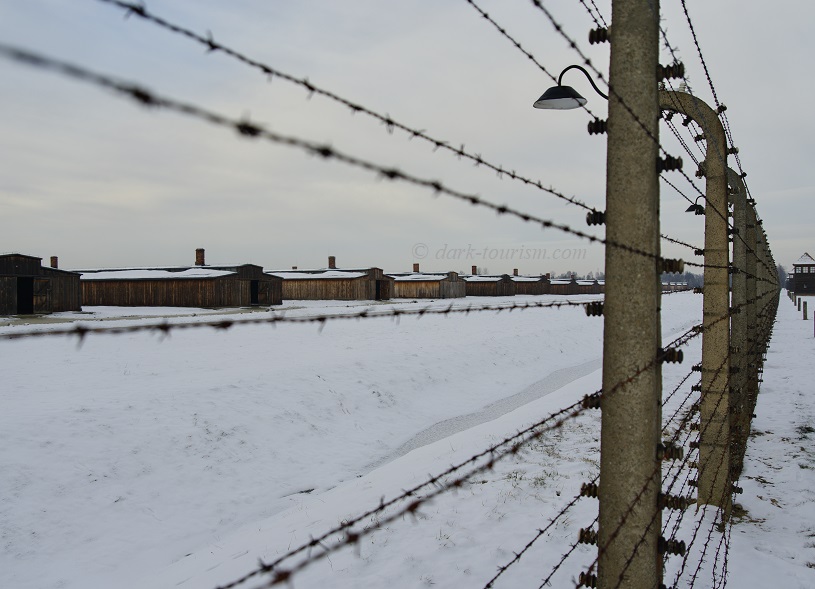
After that we killed yet more time by going back to the bookshop to warm up. This shop, by the way, is now much, much larger than the little one I found back in 2008. And these days it is indeed primarily a bookshop. They still sell a few postcards with photos from the camp, but no other sorts of souvenirs. Here we bought the small general guide brochure about Auschwitz with maps – in German, as they were out of copies in English.
By the time entry for individuals had come, quite a few people had queued up at the entrance and it took a long while for the security guards to “process” everyone, as every entry pass was checked against ID (passport) and then everybody had to pass through a single airport-like metal detector and all bags were thoroughly searched.
But once we were inside the compound we were allowed to roam freely. We first headed to the right for those wooden barracks, as most other people except one guided group were heading in other directions. Here’s a photo of the inside of one of the barracks:
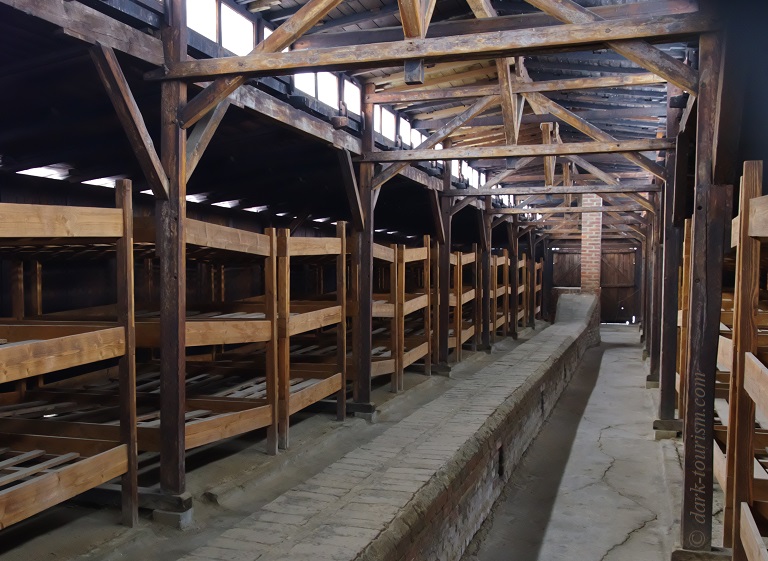
There’s now a small sign to the side of one of the rows of bunks that says that these are only replicas. I don’t remember that sign having been up when I first visited Auschwitz in 2008. I just checked my old photos and couldn’t see it on them either. So it’s probably a newer addition.
And here’s a photo of the mass latrines in another one of those wooden barracks (four of which can be accessed). No changes here as far as I could tell.
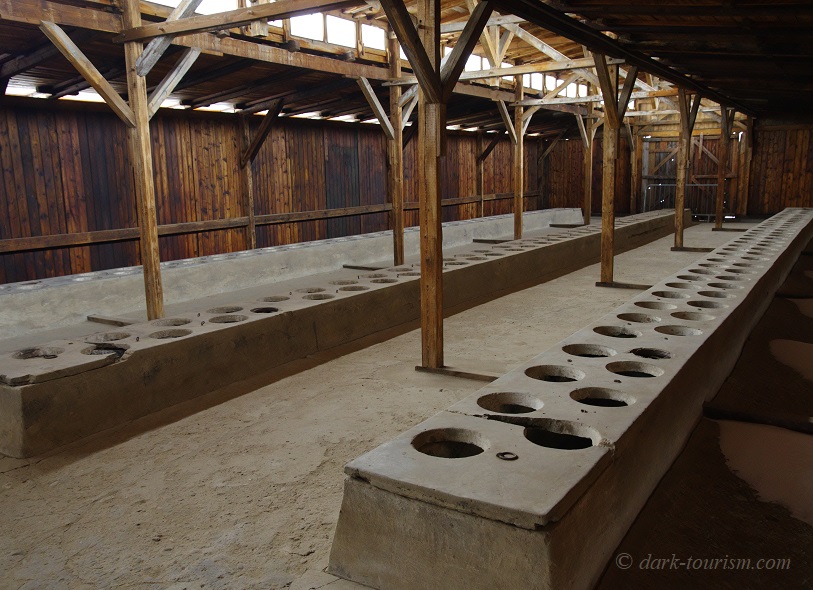
Back by the gatehouse we tried to find the way up to the central tower but couldn’t find any access. I remember clearly how our guide back in 2008 took us up there at the beginning of the Birkenau tour for the panoramic views over the barracks left and right as well as the railway ramp in the centre. Now there’s no more access to this. And you have to ask why not? Was it all of a sudden deemed inappropriate? Or is it for other reasons? I don’t know. (Back home I checked the regulations on the Auschwitz website and found that access is only allowed for guided tours and for no more than 30 people at any one time – individual visitors are indeed excluded.)
What was radically different from my 2008 visit generally was the weather. Back then it was late March and a grey drizzly day. This time it was harsh winter with snow and temperatures at minus 8 degrees Celsius (real feel minus 15!). I wore two fleeces over my shirt and T-shirt and a big coat with a long big scarf, a big woolly hat, long johns and three pairs of thick socks… but had to keep moving in order not to get too cold. And remember, at Birkenau you’re out in the open most of the time (and no accessible buildings in the camp are heated).
Halfway up the ramp I turned round to take this photo of the iconic gatehouse and what must be the world’s most infamous stretch of railway tracks:
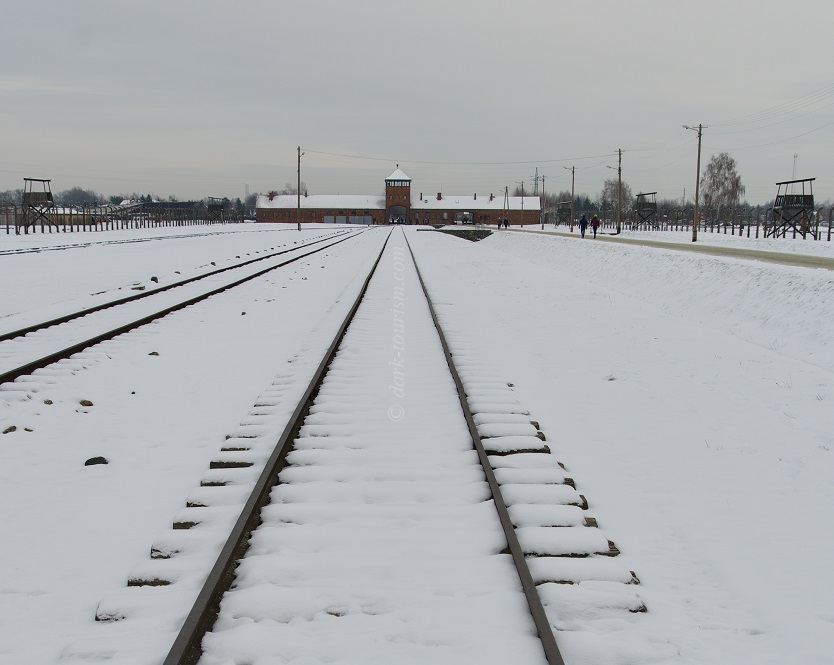
Nearby on one of those tracks stood a solitary railway car of the sort used in the deportations to Auschwitz (same photo as the featured one at the top of this post):

This had also not yet been there when I was on my first visit to Auschwitz in 2008. I initially wondered whether it had been moved here from the location at the old ramp, which was outside the camp en route to Auschwitz 1. But that evening in the hotel bar I was told by the bus driver of one of those school study trips that the pupils in his group had gone to the old ramp to lay down flowers by the railway cars there, so they must still be in place and this car inside Birkenau must be a newer addition.
The biggest change at Birkenau compared with my visit in 2008 was that it felt so restricted AND reduced. Back in 2008 when we were on a two-day study tour with a Polish guide we spent nearly four hours walking through all parts of the sprawling complex and entering numerous buildings. On this recent visit we spent well under two hours at Birkenau as about half of the compound was off limits and several previously accessible buildings were out of bounds too. I had known from the official website that the “Canada” part would be inaccessible (that’s the name that was given to the warehouses where the Nazis stored all those personal belongings plundered from the gassed Jews – and it was so named because here, like – allegedly – in Canada, “everything” could be found). But in actual fact the entire northern part of the camp was roped or fenced off. It was only possible to get as far as the central memorial monument by the end of the rail tracks. That way the ruins of the eastern crematoria were inaccessible, as well as those of “bunker” 1 and II (aka ‘red house’ and ‘white house’, respectively; these were the first gas chambers at Birkenau), the ponds with victims’ ashes, the Soviet POW cemetery and the “Zentralsauna”, which I remember as one of the most impressive and engaging parts of all of Auschwitz. (This is the intact building where victims had their hair shorn and were disinfected and given a number – when I was there in 2008 some artefacts were on display and there was a wall of many hundreds of private photos of victims from happier times, which I remember really touched me).
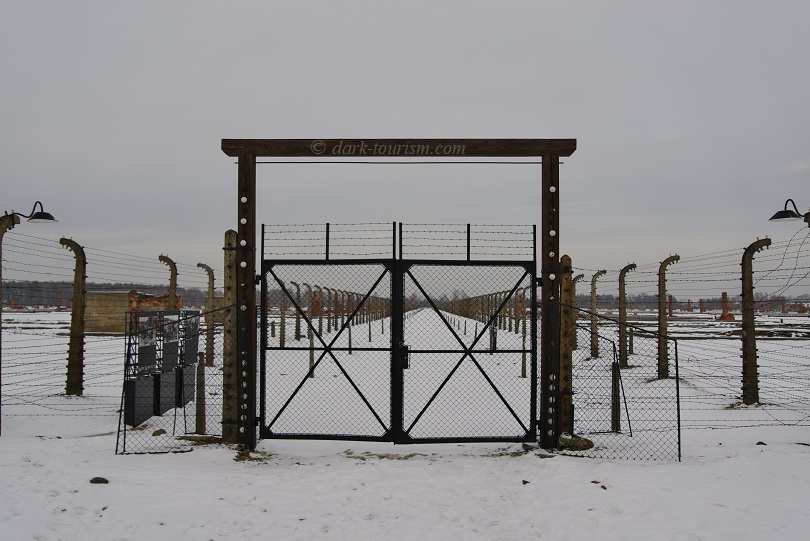
In the southern part, which is mostly comprised of single-storey brick barracks, several I remember from my 2008 visit were also not accessible (although some sleeping barracks and a couple of wash houses were). And I saw that some buildings had modern temporary superstructures over them as, presumably, conservation work is going on inside.

Several of the other inaccessible brick barracks featured wooden stabilization structures on their walls to stop them from caving in. So indeed time has taken its toll and evidently rendered many of these structures unstable.
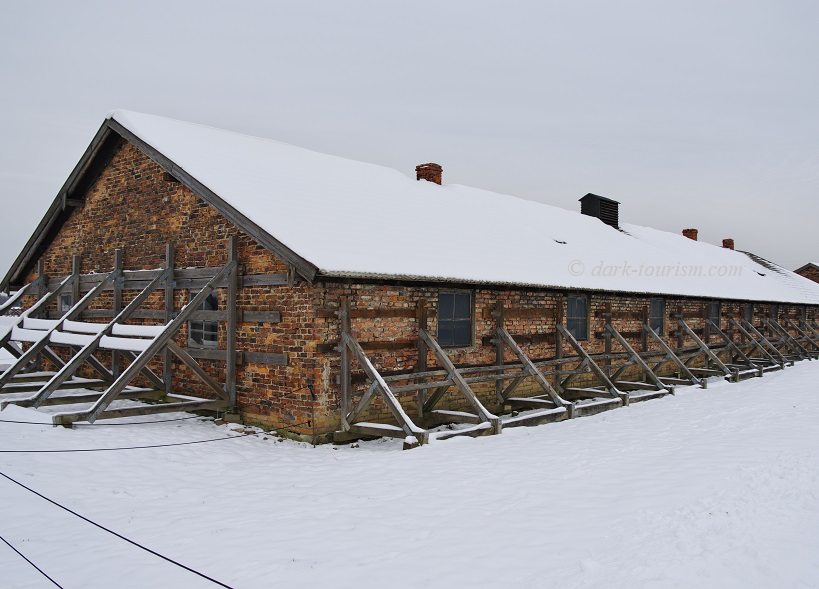
There is now also a new exit in the outer fence through which visitors leave the compound instead of going back to the gatehouse (which, however, is also still possible). The gate in the fence stands open so I suppose it would actually be relatively easy to just sneak in through that, despite the signs forbidding this. But I didn’t see anybody daring that. And given the fierceness of the tough security guards neither would I have …
The next day we had set aside for a thorough visit of Auschwitz 1. We made it there in good time to get tickets for the first German-language guided tour of the day. The queues weren’t so bad that morning so obtaining our tour tickets and individual entry passes for afterwards didn’t take long. We used the spare time before admission to look around the new entrance area and car park, with new toilet facilities and a locker room. Work is still going on. A new hostel and visitor centre are currently under construction, presumably in the main for those school groups that have resumed coming after the pandemic (visitor numbers in general are said to be heading back towards the two-million per annum mark they had broken through before Covid).

I also noted that there is no longer a fast-food outlet right in the car park, as had been the case at the old car park in 2008. There is also no café at Auschwitz 1, just a few coffee- and soft-drink vending machines.
Entry to Auschwitz 1 is even more strictly regulated these days. The new entrance is in a brick ancillary building now, no longer in the former main reception building that new prisoners also had to pass through back when Auschwitz was in operation. I wonder whether that move was made because of criticism of the fact that modern-day visitors entered through the same building as prisoners back then. If so, they still spoilt any gain in perceived appropriateness by what comes after the new entrance – I’ll come to that in a minute.
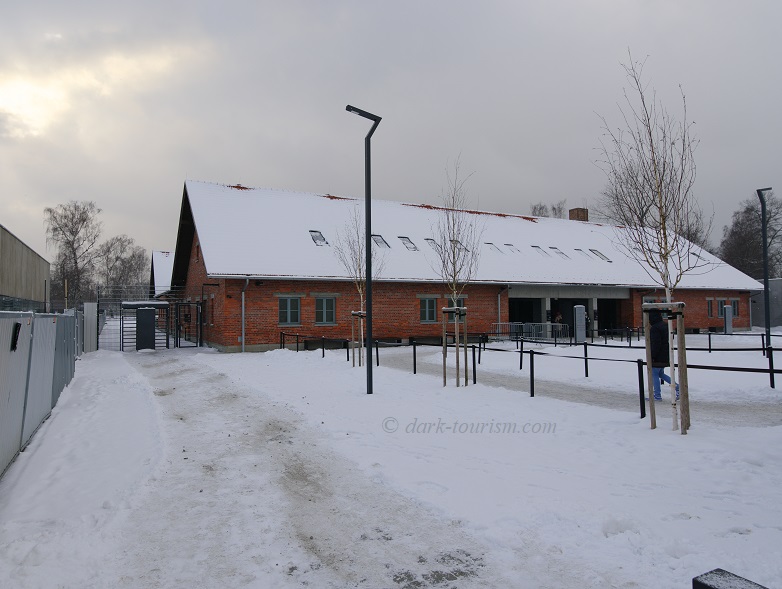
But first you have to go past the sign that details the many, many things forbidden while in the Auschwitz 1 museum’s grounds – and this included not only no food, drink or smoking but also things like no putting down of candles, no music, no weapons (hey, obviously!!), no dogs, no bikes, no use of mobile phones indoors, and also no strollers indoors. The latter perplexed me a bit, given that the museum states it’s unsuitable for youngsters under the age of 14. But as I saw later, that’s a rule/recommendation ignored by quite a few …
Again you have to have your ID and entry pass/tour ticket at the ready for inspection and then proceed through proper airport-style security gates, with bag checks and emptying of pockets (at least they didn’t make us take off our winter boots!).
You then have to wait in a large “holding hall” for your allocated tour to begin – which is signalled by the guide holding up a sign with the name of the language that the tour will be conducted in at its scheduled time slot. By the way, my wife and I opted for a German-language tour – on the basis of our experience with our excellent German-speaking guide on our two-day study tour of Auschwitz back in 2008 … and also from the snippets of English I overheard tour guides speaking the previous day at Birkenau. In contrast to Polish-tinged imperfect English I actually love the sound of a Polish accent in German. We soon found that our decision was the correct one. We had a nice, middle-aged Polish woman who softly spoke virtually flawless German (I noticed just one single little grammatical mistake in her narration during the entire tour!) and she had a mild version of that accent I so adore. During the tour we passed many a group with English-speaking guides that day, and my suspicion that it’s a bit hit-and-miss with English at Auschwitz was only confirmed by what I managed to eavesdrop on.
Our group of about 15-20 participants was first led down some rusty-metal-plated stairway and through another large room with concrete columns – which uncannily reminded me a bit of a Birkenau gas chamber.
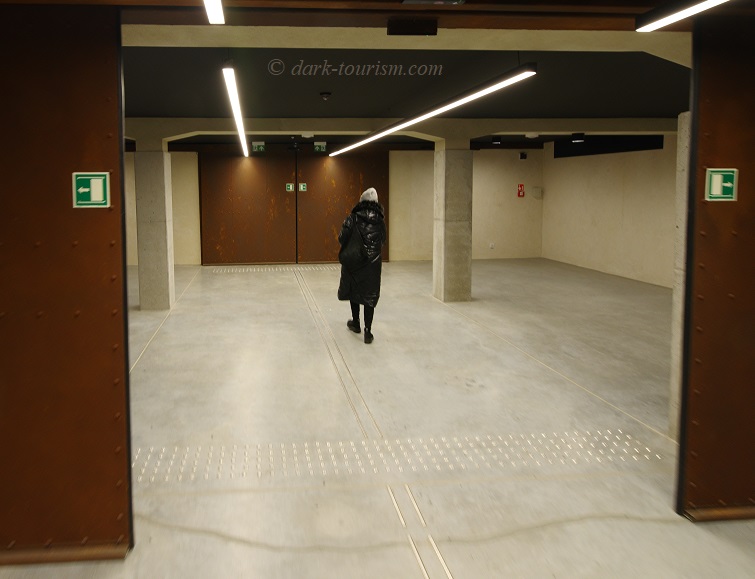
Afterwards we passed through a zigzagging concrete-walled passageway (in silence, as the names of victims were piped through speakers along the way) and then used the concrete tunnel under the road to get to the site of the former camp proper.

The whole thing, in turn, had an uncomfortable semblance of the “Schlauch” (literally ‘hose’) passageways that victims at the Operation Reinhard death camps were herded through en route to the gas chambers (those camps were Bełżec, Sobibór and Treblinka). I’m sure not many other visitors would make those connections, but if you’re as familiar with the minutiae of the Holocaust and its sites as my 16 years plus of engaging in and writing about dark tourism have made me, then this entry design does leave a certain uncomfortable feeling …
Emerging on the other side of the tunnel we were first led to the cinema room, which is still in the former reception building, but has seen some modernization. You had a wide choice of languages for the soundtrack on your headphones and while most of our group naturally went for German I decided to go for the English here – and it was American English (in a deep low dramatic voice, whereas the German was a neutral female voice). The intro film felt more like a tourist promo video (emphasizing the “experience” visitors of today can gain here) but also had the very basics of the history involved.
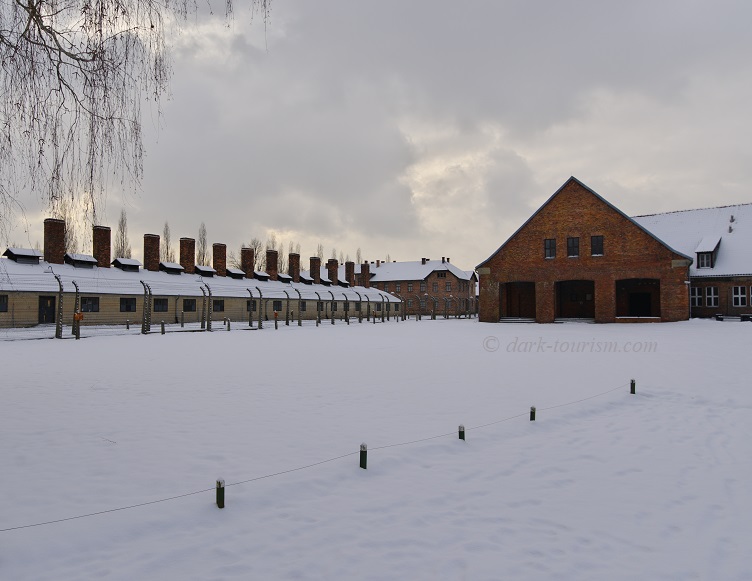
From the former reception building we were then led past the camp kitchen and approached what is surely the most infamous and iconic part of Auschwitz 1: that sign “Arbeit macht frei” (literally ‘work sets you free’) above the gate to the prison part of the camp. This has basically become THE single most recognized symbol of the Holocaust.
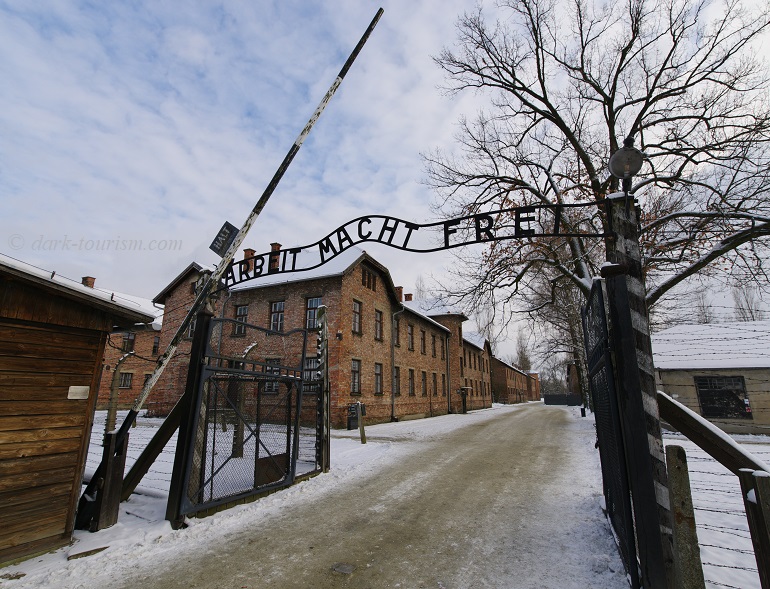
I didn’t take this photo during the tour, though, but afterwards at a moment (see below) when for once there were no crowds of other visitors congregating at or near it – a rare chance of getting a photo of this without people in the frame.
The sign, by the way, is a replica these days. This was installed after the original was stolen in 2009. The thieves were eventually caught and the sign was recovered (cut into pieces), but the museum decided to rather keep the original in secure storage and leave the replica above the gate.
We then entered the actual prison part of the camp – and again I was struck (like presumably many others too) by how “harmless” it actually looks these days, with its neat rows of two-storey brick blocks and tall trees growing between them.
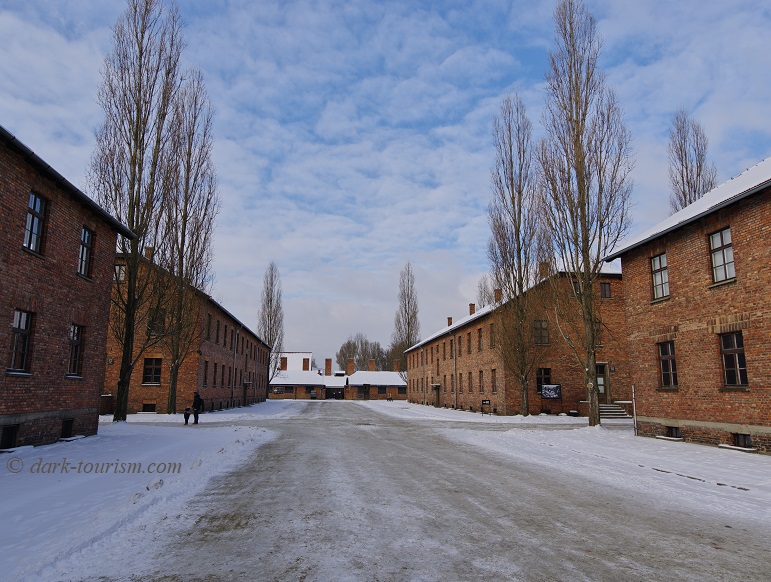
Again I managed to get an almost people-free shot in here – except for those two figures on the left: a man and a rather small child (perhaps two or three years old), who was bawling his eyes out while the father (I presume he was) was trying to calm him down. I don’t think the distress was caused by what there was to see in the museum (he was too young for that really), but I was quite taken aback by the fact that someone would take small children to a place like Auschwitz. The museum’s official policy is that a visit is “not recommended” for under 14-year-olds. Yet I later also saw a couple of small families with children clearly under that age but old enough to understand what was being narrated by the guide on the tour. You have to wonder what made these parents choose to take their kids along: was it ignorance, negligence or actually a deliberate (and rather tough) parenting decision?
Several of the brick blocks house exhibitions, the general official one (which has five parts in different blocks) plus a number of thematic and/or country-specific extra exhibitions. Our (childless) tour group was next led into the main one of the general exhibition in Block 4 entitled simply “extermination”. It is here that you get to see the very grimmest of exhibits, including a scale model of one of the gas chambers/crematoria (in operation!). Block 5 next door has exhibits of items plundered from the victims. In 2008 there was a general no-photography rule in force in this part. This has meanwhile been relaxed. There’s still no photography allowed in the room where a giant heap of human hair is on display, shaved off female victims in ca. 1944. But we were allowed to take pictures of the heaps of suitcases, shoes, prosthetics and spectacles. So here I can include a photo of the shoe heap:

I wonder what informed the policy change. Could it be that the hair was deemed inappropriate to photograph because it’s seen to constitute human remains? Whereas the inanimate objects, former belongings of victims, were deemed less sensitive? Probably so.
As regards the suitcases, with names of their owners on them (as victims of the gas chambers were tricked into believing that they were only taking a shower and would later retrieve their clothing and cases): I remember well from my 2008 visit how one particular suitcase brought the whole tragedy closer to home for me because the address written on the case was of a house next door to the primary school I had attended in Hamburg when I was little. I told the private guide who I had back then about this and then he allowed me one shot as an exception to the then no-photography rule. On my return visit I was free to take pictures of all the cases – but I could not find that particular case I had photographed in 2008 on this occasion. Apparently the museum made changes to which cases were put on display and which were to be kept in storage out of public view – and one has to wonder on what criteria such changes are based. Anyway, here’s a photo of the heap of cases I saw this time around:
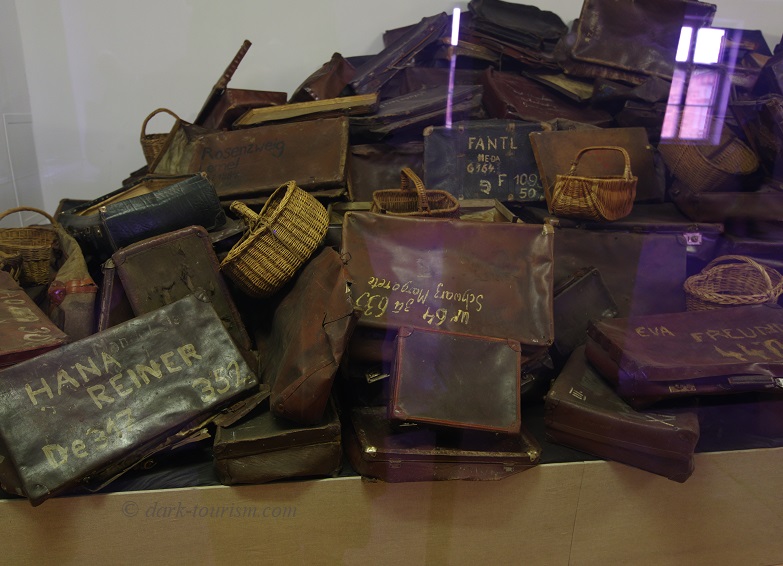
Another place where photography was still forbidden was in the basement of the camp prison with its isolation cells and tiny standing cells; in the rest of the block photography was allowed now. Some blocks, such as the one where medical experiments were conducted on inmates, were included in our guide’s narration but not entered. None of the country-specific blocks (or ‘pavilions’ as they are also referred to) were part of the tour.
Towards the end of the tour of the grounds of Auschwitz 1 we passed from the roll-call square to the edge of the prison camp with a watchtower and double electric barbed-wire fence. By that time the sun had come out …
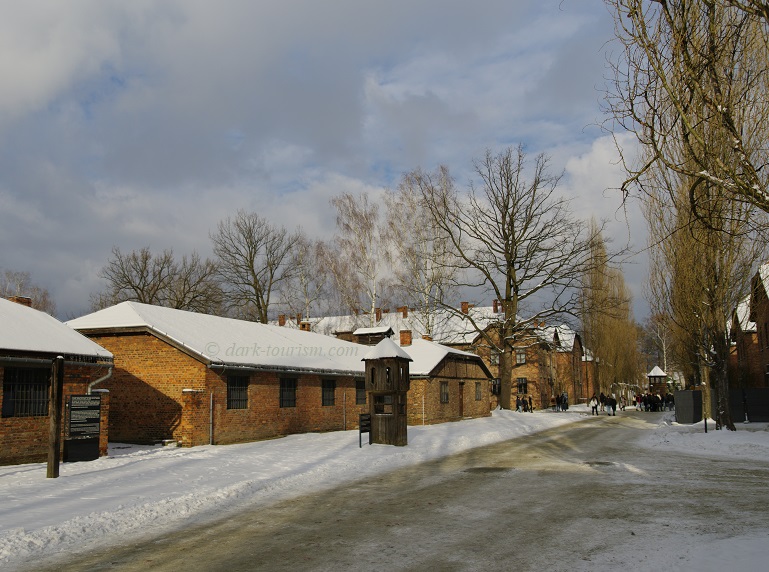
Also visible on the extreme left of this photo is part of the gallows used for public executions inside the camp. The wooden structure in the centre was to protect the SS officer conducting the roll-call from the elements if needed, while the inmates had to endure any weather unprotected, of course.
Here’s a rather grim photo of one of the watchtowers, the electric fence and the “stop” sign in front with its skull and crossbones symbol:
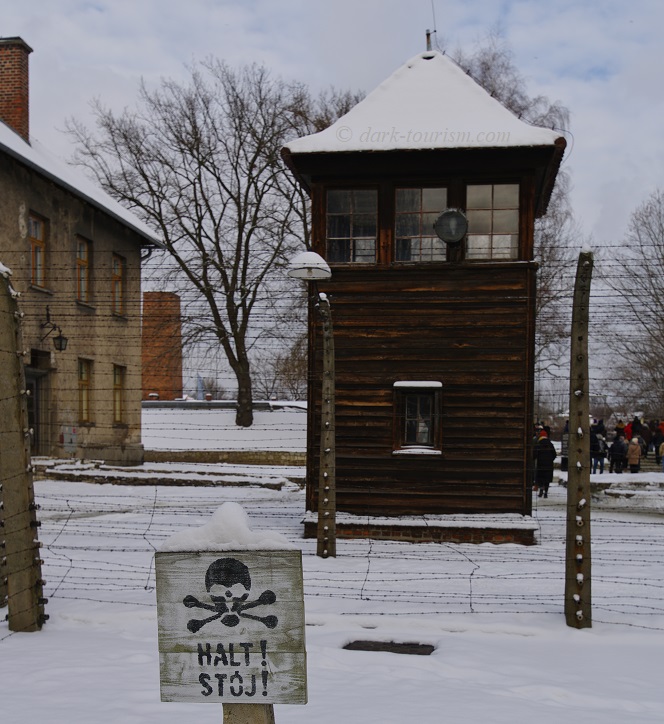
Beyond the fence, so just outside the prison part of the camp, stands the gallows on which former camp commandant Rudolf Höss was executed in 1947:
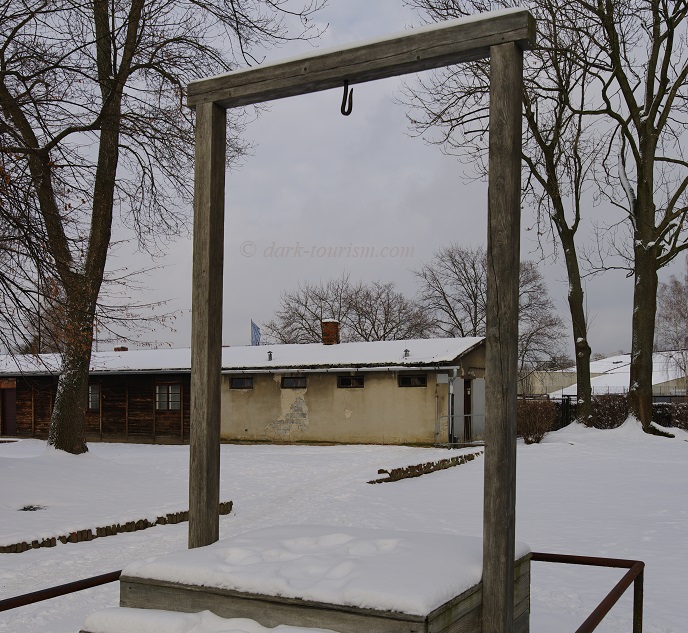
A bit to the east of this, looking over a fence, we were able to spot the private villa in which Höss and his family had lived, but the house itself was not accessible. Instead we were led into the small building with the “experimental” gas chamber of Auschwitz 1 and the adjacent small-scale crematorium, with just two ovens:
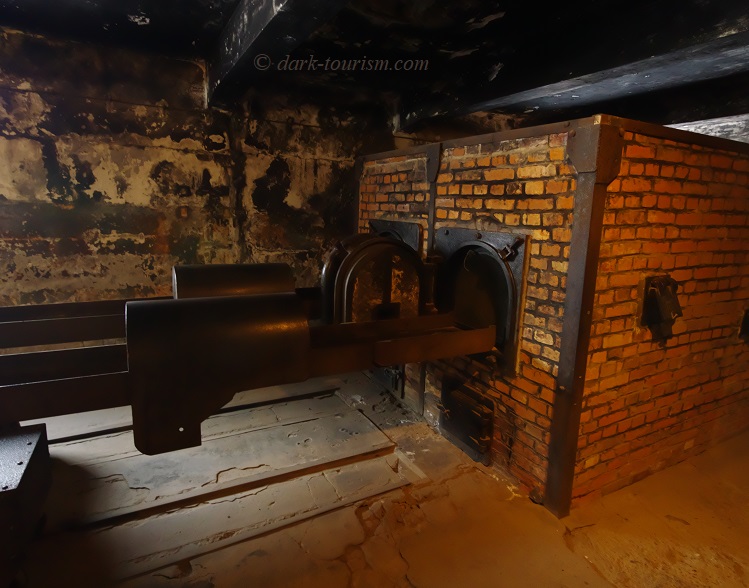
The gas chambers and crematoria at Auschwitz-Birkenau were on an altogether different, “industrial” scale, but since those were all blown up by the SS before the camp was “evacuated”, these at Auschwitz 1 are the most intact remnants of this sort here (whereas at Majdanek you can still find intact larger gas chambers and a full-scale crematorium – for the latter see also the Topf & Söhne memorial site).
The tour then headed back to the entrance and the desk where the headphone sets were returned and where there was also a very large bookshop. After a little break the tour would continue with a transfer to Birkenau and another hour or so of guided tour there. Since my wife and I had already “done” Birkenau the day before, we asked if we could drop out of the tour at this point and stay behind to see the country pavilions that were not part of the tour. That way we could avoid going through the tight security procedure yet again. At first the guide was a bit reluctant but then indicated to us to just walk back through tunnel and explore independently – our individual entry passes were scheduled to become valid in about half an hour’s time.
At that point the last few groups of the morning were coming to the end of their tours and as it was before the official 1 p.m. start for admission for individual visitors we had a time window in which there were hardly any other people inside the compound. That allowed me some good people-free photos, including the one featured above of the iconic gate and the sign above it.
Our main destination back inside the camp was the Austrian pavilion. That’s because back in 2008 the then Austrian exhibition was introduced by a sign that said that the narrative of the old exhibition no longer represented the contemporary view of Austria’s role in Nazism, WWII and the Holocaust. Indeed the old exhibition had still run on that “first victim of Nazism” theme that was preferred in Austria over the first four or five decades after the war. But things have changed. I actually attended a public lecture/seminar in Vienna about the reworking of the Austrian Auschwitz pavilion. So now was the chance to finally see the end result.
Indeed the new Austrian exhibition turned out to be very different from its predecessor. The new narrative included the view that during the Nazi years many Austrians were either ardent Nazis themselves, apathetic or profiteering. Only a very small minority was in the Austrian resistance against the Nazis. The exhibition has few artefacts but lots of text, images and documents, some interactive but mostly on static back-lit glass panels. There’s no natural light and the lighting is quite gloomy (as seems to be the current preferred memorial museum style).
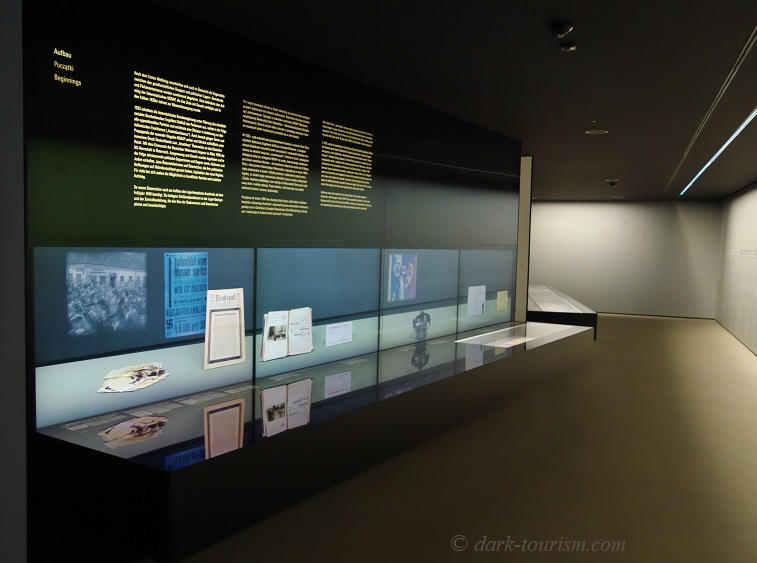
We also visited the Hungarian, Dutch/Belgian, French, Czech and Roma & Sinti pavilions, all of which didn’t seem to have changed much. What I couldn’t find at all was the Italian pavilion (which I remember from 2008 to have been especially bizarre and abstract). The Slovakian exhibition was temporarily closed (maybe also for a reworking; that would be in line with the topic of the Holocaust in Slovakia having only recently come to the fore in that country – see Sered). The Polish exhibition was also fenced off and evidently undergoing larger-scale changes. Closed too, but not because of ongoing refurbishment, was the Russian pavilion. You can imagine why.
The Jewish-Israeli pavilion was quite different from what I remembered from 2008. It was also the most visual and acoustically embellished of the extra exhibitions. One very unusual section had a room with tiny doodles on the white walls in a style you’d expect from children. That gave the imagery a weird and chilling extra dark element in its own way. (I initially wanted to include an example photo of such a drawings at this point, namely one depicting the Birkenau gatehouse, ramp and a selection scene, in such “naïve” childlike style, but then I thought better of it for fear of potential copyright infringement. But if you’re interested in seeing it, contact me and I can send it you privately.)
By the time we got to the final pavilion my wife and I had slowly reached saturation point, so only skimmed through the Roma & Sinti pavilion quickly and then headed to the exit.
En route I took one last atmospheric photo of the double electric fence with the lamps between them …
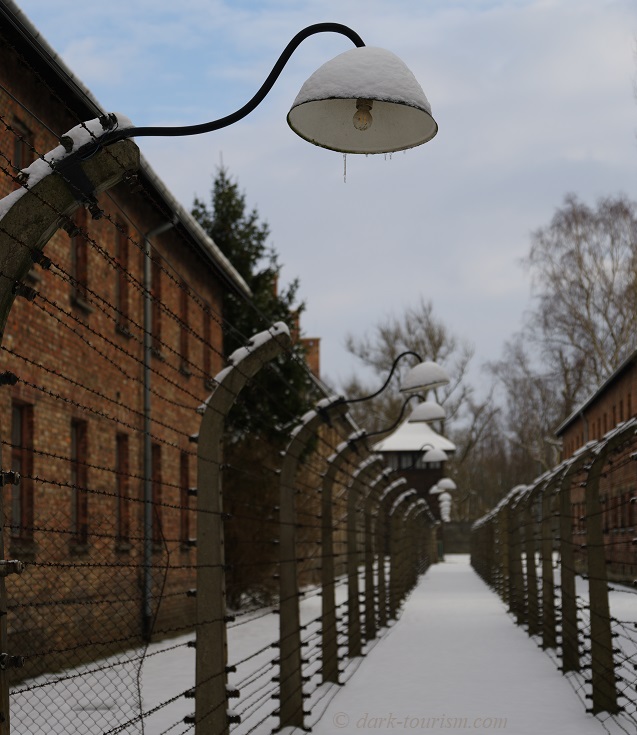
All in all it was a very useful visit which brought lots of new information, especially about the various changes reported in the above, all of which will now also have to be fed into the rewriting of the Auschwitz chapter on my main website. That’ll be quite a bit of work.
On balance I must say that Auschwitz had less of an impact on me this time around than had been the case back in 2008. Partly that’s only natural as it was a re-visit, so I already knew what to expect. But maybe also because I had in the meantime visited every single one of the main Nazi concentration camp memorial sites in Poland, Germany and elsewhere. It could well be that this has brought with it a certain “emotional blunting”. The shock effects have simply worn off, psychologically. Even though intellectually they will always remain.
But I also found that it was Auschwitz itself, especially the increased security regulations, the “crowd management” and the many closed-off parts, that had a certain dulling effect. Much of this is of course due to the fact that Ausch witz now suffers from what has become known as “overtourism”. And even in the most off-season time of year I felt that this was indeed the case. I don’t want to try and imagine what the onslaught of masses of tourists in high season must be like.
More than ever, therefore, my advice to people wanting to see something like Auschwitz without the same level of mass tourism is: go to Majdanek instead, which is nowhere near as overrun and actually has more place authenticity and surviving original structures.
But so much for now, on this year’s Holocaust Remembrance Day, 79 years after the liberation of Auschwitz …




4 responses
Vielen Dank für den sehr interessanten Bericht!
Warum wurde der Eingang verlegt? Das würde sich für mich komisch anfühlen, so nicht echt eben. Liebe Grüße Anya
eine Erklärung hab ich nie gefunden – kann also auch nur spekulieren, so wie ich es in dem Blog-Post ja auch getan habe …
I visited in August 2024 and the closed part was open, I could roam around freely and enter to almost any place, except the building at the far end of the camp with showers. An unforgettable visit indeed!
thanks for the update – good to know that some of the closed parts have re-openend. How full was it in August?